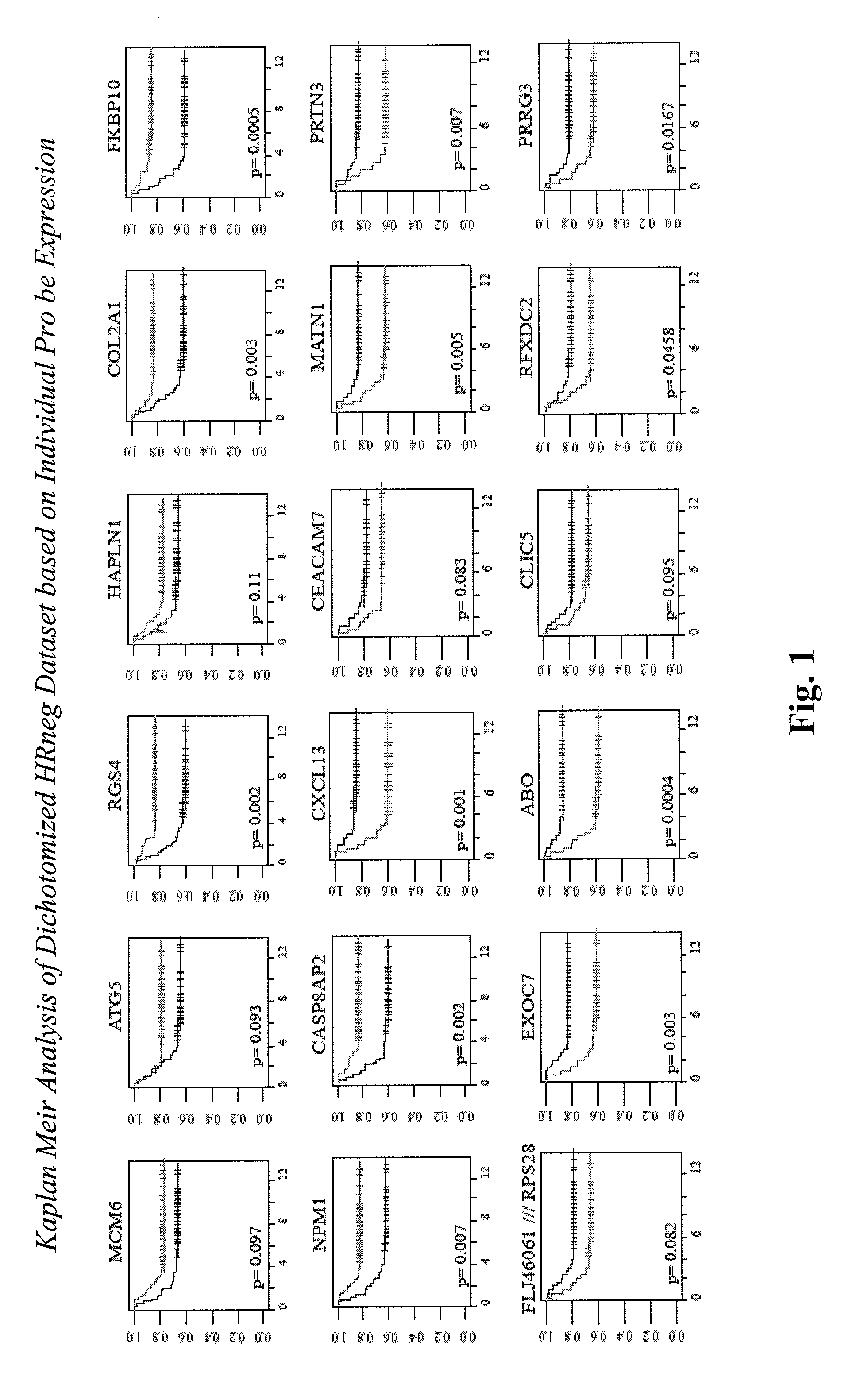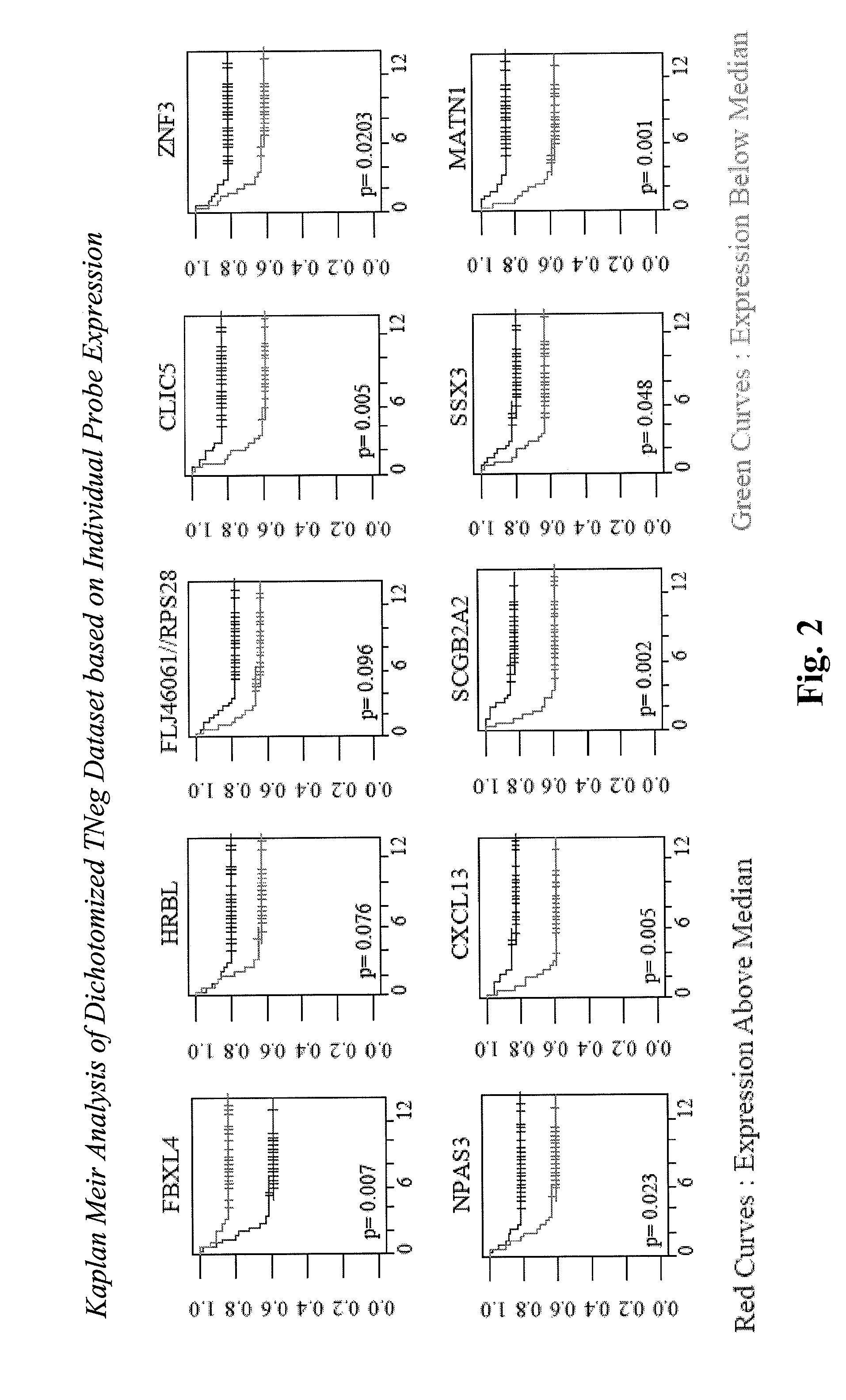Multi-gene classifiers and prognostic indicators for cancers
a multi-gene classifier and cancer technology, applied in the field of multi-gene classifiers and cancer prognostic indicators, can solve the problems of not being able to validate the prognostic gene signature for the clinically problematic subset of hrneg, and the analysis often fails to identify and accurately prognostic the fate of clinically problematic breast cancer subtypes, so as to increase the frequency of medical monitoring, increase the risk of metastatic recurrence, and the dose or frequency of chemotherapy
- Summary
- Abstract
- Description
- Claims
- Application Information
AI Technical Summary
Benefits of technology
Problems solved by technology
Method used
Image
Examples
example 1
A. Example 1
[0158]135 untreated, node-negative (NO), ER-negative primary breast cancers (HRneg) were identified from published studies which used the Affymetrix U133A microarray platform (Wang et al., 2005, GSE2034; Minn et al., 2007, GSES327). Array data was log2 transformed. Based on the cumulative distribution of mean-centered, log2 transformed ERBB2 mRNA transcript level (Probe Set ID 216836_s_at), a subset of 108 cases were identified as Tneg.
TABLE 2Number of tumors identified as HRneg or TnegHRnegTnegMetastaticMetastaticEventsCensoredEventsCensoredWang et al cases27502139Minn et al cases11471038
[0159]The training dataset was subdivided by data source (Wang et at and Minn et at cases). Using PAM, ˜300 top discriminating probes between metastatic and non-metastatic cases were identified from each subset. Probes commonly selected from both subsets, with consistent directionality in the PAM importance score, were included in the next phase of the analysis.
[0160]A minimum variation...
example 2
B. Example 2
[0167]Sixty-four untreated, NO HRneg primary breast cancers (24 metastastic cases) similarly analyzed using the Affymetrix platform were identified from the TRANSBIG multicenter validation series (Desmedt et al. 2007, GSE7390). Expression measures were generated using the RMA algorithm in Bioconductor R. Based on the cumulative distribution of the mean-centered ERBB2 transcript level (Probe 216836_s_at), a subset of 46 cases (23 metastasis) were identified as Tneg.
[0168]Univariate Cox analysis was performed based on the prioritization dataset. Candidates with Cox coefficients bearing the same sign as in the original Cox analysis of the training data set are deemed higher priority candidates and included in the next phase of the analysis.
[0169]Multi-variate Cox analysis was performed based on the priorization dataset. Genes with Cox coefficients bearing the same sign as in the original Cox analysis of the training data set are deemed highest priority candidates. Summation...
example 3
C. Example 3
[0172]37 untreated, N0 HRneg tumors were selected from the NKI study (Netherlands Cancer Institute; see Van de Vijver et al. 2002) analyzed using the Agilent platform (13 metastastic cases). Based on the adjusted expression of 6 higher priority candidates found on this array platform (MATN1, ABO, RGS4, PRTN3, CLIC5, RPS28), a summation index was computed; and Kaplan Meir analysis was performed.
[0173]The result of the Kaplan-Meier analysis was that the summation index calculated based on expression of six higher priority candidates is prognostic in the NKI HRneg tumor set, as shown in FIG. 7.
[0174]Therefore, hierarchical categorization of 24 different original HRneg or Tneg prognostic gene candidates produced two 1st (CLIC5, CXCL13), five 2nd (PRTN3, FLJ46061 / RPS28, SSX3, ABO, RGS4), and seven 3rd (ZNF3, HAPLN3, EXOC7, RFXDC2, PRRG3, MATN1, HRBL) level candidates for further evaluation by RT-PCR analysis using a larger set of untreated HRneg or Tneg breast cancers associa...
PUM
| Property | Measurement | Unit |
|---|---|---|
| Fraction | aaaaa | aaaaa |
Abstract
Description
Claims
Application Information
 Login to View More
Login to View More - R&D
- Intellectual Property
- Life Sciences
- Materials
- Tech Scout
- Unparalleled Data Quality
- Higher Quality Content
- 60% Fewer Hallucinations
Browse by: Latest US Patents, China's latest patents, Technical Efficacy Thesaurus, Application Domain, Technology Topic, Popular Technical Reports.
© 2025 PatSnap. All rights reserved.Legal|Privacy policy|Modern Slavery Act Transparency Statement|Sitemap|About US| Contact US: help@patsnap.com



